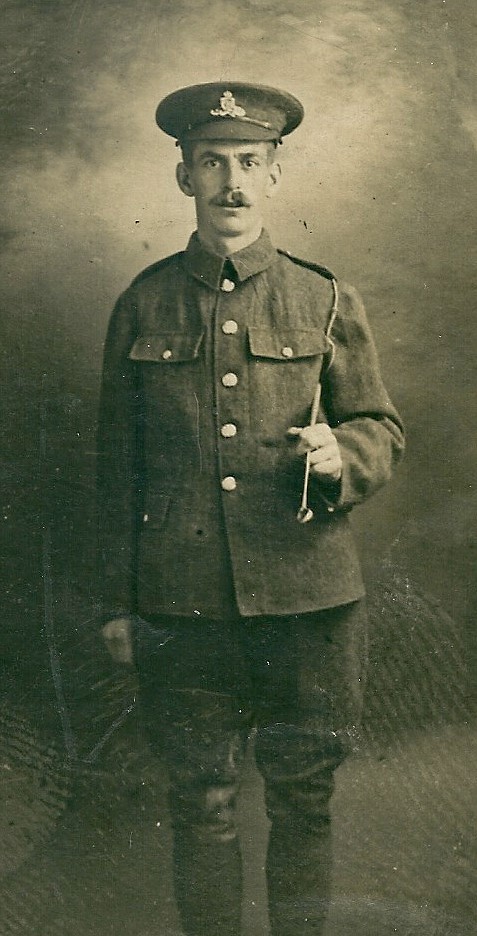Gnr
Horace Duke
Information about birth
|
Date of birth: 14/07/1884 |
|
Place of birth: Sheffield, Yorkshire, England, United Kingdom |
General information
|
Profession: Bricklayer |
Army information
|
Country: England, United Kingdom |
|
Force: British Expeditionary Force |
|
Rank: Gunner |
|
Service number: 152866 |
|
Enlistment place: Doncaster, Yorkshire, England, United Kingdom |
|
Units: — Royal Field Artillery, 50th Bty. 34th Bde. (Last known unit) |
Information about death
|
Date of death: 24/10/1917 |
|
Place of death: 46th Casualty Clearing Station, Proven, Belgium |
|
Cause of death: Died of wounds (D.O.W.) |
|
Age: 33 |
Cemetery
|
Mendinghem Military Cemetery Plot: VII Row: F Grave: 38 |
Distinctions and medals 2
|
British War Medal Medal |
|
Victory Medal Medal |
Points of interest 3
| #1 | Place of birth | ||
| #2 | Enlistment place | ||
| #3 | Place of death (approximate) |
My story
Gunner Horace Duke - a thirty-three-year-old bricklayer from Doncaster, Yorkshire – died during the Battle of Passchendaele. He served in the 50th Battery of the 34th Brigade Royal Field Artillery.
On 4 October 1917 it was decided that the 34th Brigade had to move its guns to new positions to the southeast of the village of Langemark, near a group of ruined buildings dubbed: Dog Houses, Rat House, Cat House, Snipe House and Grouse Farm. The next following days the men worked on preparing their new forward positions in dreadful circumstances. The roads and the ground were in a terrible condition, due to the rain and continuous shellfire. All Batteries were up and active again on 9 October.
The new positions of the Brigade along the Langemark - Zonnebeke Road were known to the German artillery and shelling was a daily reality. During the night of 18 and 19 October all Battery positions were targeted. Two guns of the 70th Battery were knocked out and several ammunition dumps were destroyed. The 50th Battery took the full brunt and was relieved on the 19th after suffering heavy casualties.
Horace was wounded in the days running up to the 24th of October 1917, when he succumbed to his wounds in a Casualty Clearing Station near the village of Proven. He left behind his wife Gertrude and his six-year-old daughter, Linda. Horace was laid to rest in Mendinghem Military Cemetery.
On 4 October 1917 it was decided that the 34th Brigade had to move its guns to new positions to the southeast of the village of Langemark, near a group of ruined buildings dubbed: Dog Houses, Rat House, Cat House, Snipe House and Grouse Farm. The next following days the men worked on preparing their new forward positions in dreadful circumstances. The roads and the ground were in a terrible condition, due to the rain and continuous shellfire. All Batteries were up and active again on 9 October.
The new positions of the Brigade along the Langemark - Zonnebeke Road were known to the German artillery and shelling was a daily reality. During the night of 18 and 19 October all Battery positions were targeted. Two guns of the 70th Battery were knocked out and several ammunition dumps were destroyed. The 50th Battery took the full brunt and was relieved on the 19th after suffering heavy casualties.
Horace was wounded in the days running up to the 24th of October 1917, when he succumbed to his wounds in a Casualty Clearing Station near the village of Proven. He left behind his wife Gertrude and his six-year-old daughter, Linda. Horace was laid to rest in Mendinghem Military Cemetery.
Sources 5
|
Ancestry https://www.ancestry.co.uk/ Sources used |
|
British army ancestors https://discovery.nationalarchives.gov.uk/details/r/D2700884 Sources used |
|
CWGC https://www.cwgc.org/find-war-dead/casualty/437357/duke,-horace/ Sources used |
|
Long Long Trail https://www.longlongtrail.co.uk/?domain=www.1914-1918.net Sources used |
|
War Diary http://www.nmarchive.com/ Sources used |
